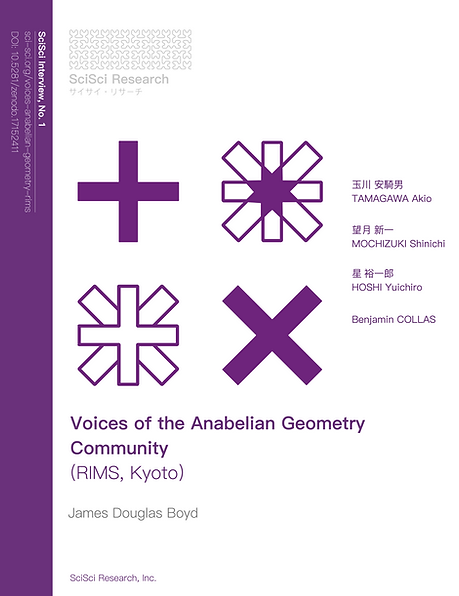Voices of the Anabelian Arithmetic Geometry Community (RIMS, Kyoto)
SciSci Interview, No. 1
January 2025

James Douglas Boyd
Founder, CEO
Discipline
Pure mathematics
Institutions and Partners
▣ Research Institute for Mathematical Sciences (RIMS; 数理解析研究所), Kyoto University (京都大学)
▣ Arithmetic and Homotopic Galois Theory (AHGT), Centre national de la recherche scientifique (CNRS)
Participants
▣ TAMAGAWA Akio (玉川 安騎男): Professor, RIMS
▣ MOCHIZUKI Shinichi (望月 新一): Professor, RIMS
▣ HOSHI Yuichiro (星 裕一郎): Associate Professor, RIMS
▣ Benjamin COLLAS: Researcher, RIMS; Main Coordinator, AHGT (CNRS)
Topics
Anabelian geometry (e.g., combinatorial, birational, p-adic), Grothendieck's anabelian conjecture, resolution of non-singularities, inter-universal Teichmüller theory (IUT), cyclotomic synchronization, Grothendieck-Teichmüller theory, the Section Conjecture, etc.
Resolution of Non-Singularities
▣ Tamagawa-sensei revisits the origins of the resolution of non-singularities (RNS) technique. These include Tamagawa-sensei's work on anabelian geometry in positive characteristic and Mochizuki-sensei's proof of Grothendieck's anabelian conjecture for smooth, proper hyperbolic curves over number fields.
▣ Mochizuki-sensei recalls Associate Professor Lepage's Berkovich-geometric RNS innovation for Mumford curves, and the process whereby Mochizuki-sensei acquired a scheme-theoretic understanding of Associate Professor Lepage's approach in terms of the multiplicative and additive structure of Kummer and Artin-Schreier coverings.
▣ Mochizuki-sensei reviews the strategic position of RNS in terms of extracting data from curves mod p to arbitrary powers from the combinatorial structure of the special fiber, which is very much related to combinatorial anabelian geometry.
▣ Mochizuki-sensei gives a summary of the approach being taken for proving Grothendieck's (still open) Section Conjecture, which recent collaborative work between Mochizuki-sensei and Hoshi-sensei suggests is reducible to the local Section Conjecture plus three conditions (i.e., IF, NC, Lifting), which correspond to three (forthcoming) new versions of inter-universal Teichmüller theory (IUT). In the case of the first (Galois Orbit) new version, one ascertains bounds on heights of Galois sections by showing, locally, that they intersect the point at infinity modulo p to some n, and adding up the local n, where a bound is obtained by determining the entanglement between multiplicative and additive structure (as done in the original IUT theory).
▣ Mochizuki-sensei touches upon the relationship between RNS and the p-adic Grothendieck-Teichmüller group.
Trends in the Japanese and Global Research Community
▣ Tamagawa-sensei recalls the influence of IHARA Yasutaka (伊原 康隆), UCHIDA Kōji (内田 興二), NAKAMURA Hiroaki (中村 博昭), and MATSUMOTO Makoto (松本 眞) on his entrance to anabelian geometry.
▣ Tamagawa-sensei reflects on his reading of Uchida-sensei's work on isomorphisms of Galois groups for function fields over finite fields, which he encountered due to his interest in birational anabelian geometry. He also comments on his application of the Lefschetz trace formula and importation of Uchida-sensei's ideas to the case of fundamental groups. He also notes that Uchida-sensei's paper preceded Grothendieck's Esquisse d'un programme and letter to Faltings.
▣ Mochizuki-sensei gives his assessment of the somewhat outdated nature of Grothendieck's Esquisse d'un programme and the rapid progress being made in contemporary anabelian geometry.
▣ Tamagawa-sensei discusses collaborations with Anna CADORET, Mohammed SAÏDI, and Christopher RASMUSSSEN. Comparisons are given by SciSci between the respective collaborative-problem-solving and theory-building approaches of Tamagawa-sensei and Mochizuki-sensei.
▣ Collas comments on Associate Professor Lepage's talk given on RNS at a 2024 AHGT workshop in Paris and interfaces with the Berkovich school.
▣ Collas offers a remark on the contemporary relationship between anabelian geometry and Galois-Teichmüller theory, with the former now an input for the latter.
▣ Collas reflects on the nexus of topics (e.g., braid groups, low-dimensional topology, Oda's problem, the number theory of Greenberg and Ihara-Anderson) that have interfaced with anabelian geometry and étale homotopy.
▣ Collas mentions expressions of interest among young researchers in IUT, and his recommendation that one begin with anabelian geometry and étale homotopy.
▣ Hoshi-sensei offers his assessment of the utility of IUT in making advances in anabelian geometry, citing the work of Assistant Professor TSUJIMURA Shota (辻村 昇太), which makes use of cyclotomic synchronization.
Executive Summary
I wish to thank Professor TAMAGAWA Akio (玉川 安騎男) and Dr. Benjamin COLLAS for their invitation to RIMS, as well as the invitation of Professor FUJIWARA Kōji (藤原 耕二). I would also like to thank RIMS for its hospitality and support throughout my visit, the CNRS AHGT project for collaboration and support, and, last but not least, Professor Tamagawa, Professor Mochizuki, Assistant Professor Hoshi, and Dr. Collas for participating in the interview.

.png)